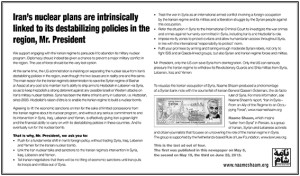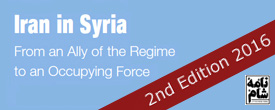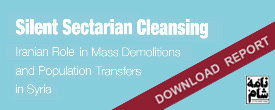The Hague, 1 July 2015 – The campaign group Naame Shaam (1) yesterday published the fourth and last open letter to US President Barak Obama in the Washington Post newspaper.
The letter focuses on the link between Iran’s military nuclear plans and its intervention in Syria and other countries in the region. It also highlights the strategic importance of Hezbollah Lebanon in Iran’s military nuclear ambitions.
“Iran’s nuclear plans are intrinsically linked to its destabilizing policies in the region,, Mr. President,” reads the headline.
The open letter continues: “We support engaging with the Iranian regime to persuade it to abandon its military nuclear program. Diplomacy should indeed be given a chance to prevent a major military conflict in the region. The use of force should be the very last option.”
“At the same time, the US administration is insisting on separating the nuclear issue from Iran’s destabilizing policies in the region, even though the two issues are in reality one and the same.”
“The main reason for the Iranian regime’s determination to save the Syrian regime of Bashar al-Assad at any cost is to maintain Iran’s ability to ship arms to Hezbollah in Lebanon via Syria, so as to keep Hezbollah a strong deterrent against any possible Israeli or Western attacks on Iran’s military nuclear facilities. Syria has been the lifeline of Iran’s army in Lebanon, i.e. Hezbollah, since 2006. Hezbollah’s raison d’être is to enable the Iranian regime to build a nuclear bomb.”
“Agreeing to lift the economic sanctions on Iran for the sake of limited concessions from the Iranian regime about its nuclear program, and without any serious commitment to end its intervention in Syria, Iraq, Lebanon and Yemen, is effectively giving Iran a green light and the financial ability to carry on with its destabilizing policies in these countries. And to eventually run for the nuclear bomb.”
The letter then asks President Obama to:
- “Push for a fundamental shift in Iran’s foreign policy, without trading Syria, Iraq, Lebanon and Yemen for the Iranian nuclear bomb.
- Link the Iran nuclear talks and sanctions to the Iranian regime’s intervention in Syria, Iraq, Lebanon and Yemen.
- Tell Iranian negotiators that there will be no lifting of economic sanctions until Iran pulls its troops and militias out of Syria.
- Treat the war in Syria as an international armed conflict involving a foreign occupation by the Iranian regime and its militias and a liberation struggle by the Syrian people against this occupation.
- Refer the situation in Syria to the International Criminal Court to investigate the war crimes and crimes against humanity committed in Syria, including Iran’s and Hezbollah’s role.
- Impose no-fly zones to protect civilians and allow humanitarian access throughout Syria, in line with the international ‘responsibility to protect’ norm.
- Fulfil your promises by arming and training enough moderate Syrian rebels, not only to fight ISIS and al-Qaeda-linked groups, but also Syrian and Iranian regime forces and militias.”
The open letter ends with the message: “Mr. President, only the US can save Syria from disintegration. Only the US can seriously pressure the Iranian regime to withdraw its Revolutionary Guards and Shia militias from Syria, Lebanon, Iraq and Yemen.”
The open letter was accompanied by a photomontage of a Syrian bank note, which Naame Shaam had produced to visualize the Iranian occupation of Syria, carrying the counterfeit of Iranian General Qassem Soleimani, the de facto ruler of Syria. (2)
Notes for editors:
- A pdf of page A3 of the Washington Post, 30 June 2015, where the open letter was published, can be found below.
- The third open letter as published in the Washington Post on June 23, 2015
- The second open letter as published in the Washington Post on May 19, 2015
- The first open letter as published in the Washington Post on May 5, 2015
1. Naame Shaam is a group of Iranian, Syrian and Lebanese activists and citizen-journalists that focuses on uncovering the role of the Iranian regime in Syria. Naame Shaam (نامه شام) means “Letter from Syria” in Persian. For more details about the group and its activities, see www.naameshaam.org.
Naame Shaam is supported by the Netherlands-based Rule of Law Foundation, www.lawrules.org.
2. See: www.naameshaam.org/new-syrian-banks-notes/
3. On 23 April 2015, a Naame Shaam representative handed a copy of the new report, “Silent Sectarian Cleansing: Iranian Role in Mass Demolitions and Population Transfers in Syria”, and other relevant information to the Office of the International Criminal Court (ICC) Prosecutor in The Hague. Naame Shaam called on the Prosecutor to open an investigation into these crimes. This should include the role of Iranian officials and commanders, particularly General Qassem Soleimani. See here.
This report was published on 18 May 2015. See here.
4. In November 2014, Naame Shaam published an in-depth report on the role of the Iranian regime in the ongoing war in Syria. See the full report, “Iran in Syria: From an Ally of the Regime to an Occupying Force”, available here.
The report provides numerous examples and case studies of human rights violations, war crimes and crimes against humanity committed in Syria by Iranian-controlled militias and forces, including the ‘crisis cell’ assassination in July 2012 and the Ghouta chemical massacre near Damascus in August 2013. It also highlights ways of bringing possible lawsuits against Iranian regime officials, such as Gen. Qassem Soleimani, the commander-in-chief of Sepah Qods, the foreign arm of Sepah Pasdaran (Iranian Revolutionary Guards).
The authors argue that there is sufficient evidence for the ICC to try the military and political leadership of Iran for complicity in various crimes committed in Syria. This ranges from inciting, endorsing and adopting specific criminal and terrorist acts to aiding and abetting war crimes and crimes against humanity. The 2014 report also presents a legal case for treating the war in Syria as an international conflict that involves a foreign occupation by the Iranian regime and its militias and a liberation struggle by Syrian people against this foreign occupation, as defined by the 1907 Hague Regulations and the Fourth Geneva Convention of 1949.
Attachment: pdf of page A3 of the Washington Post, 30 June 2015
 English
English  فارسی
فارسی  العربية
العربية 





 On Twitter
On Twitter